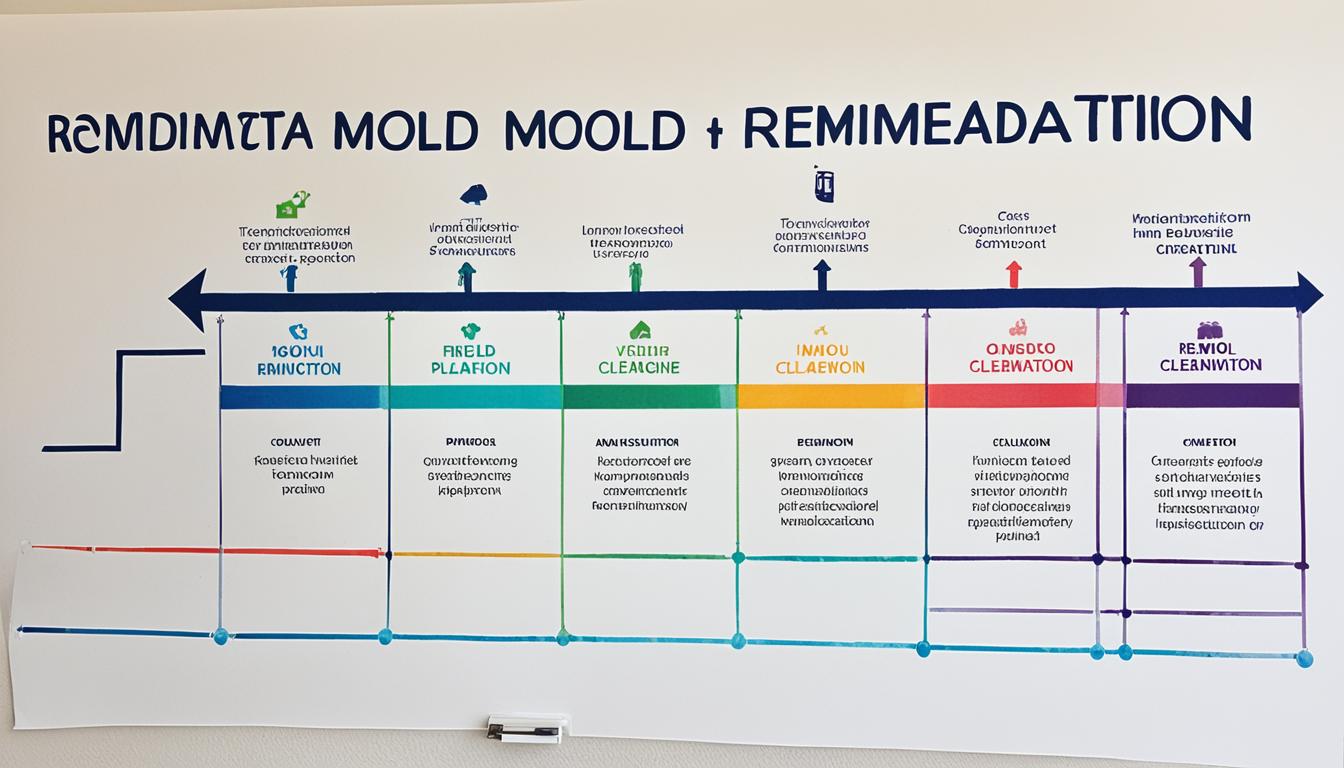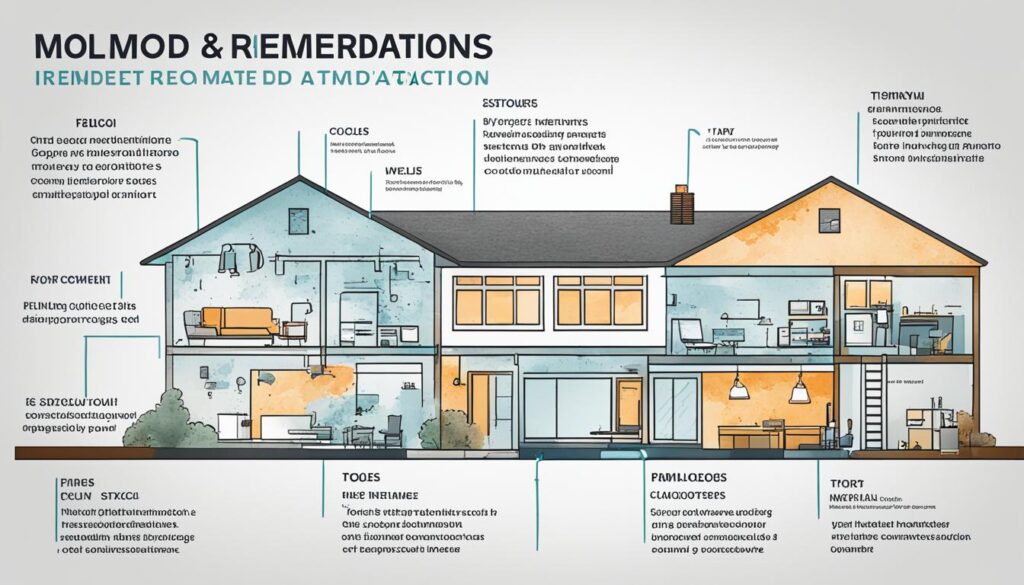
Landlord Mold Remediation Timeline Explained
In this section, we will delve into the legal obligations and responsibilities of landlords when it comes to addressing and resolving mold growth issues in rental properties. Understanding the timeline for mold remediation is crucial for ensuring tenant safety and maintaining property upkeep.
Key Takeaways
- Landlords have legal responsibilities to address mold growth in rental properties.
- Understanding the mold remediation timeline is essential for ensuring tenant safety.
- Proper maintenance and prompt resolution of mold issues help maintain property value.
- Mold inspections and repairs should be conducted within a reasonable timeframe.
- Complying with local health and safety codes is crucial for landlords.
The Importance of Addressing Mold Growth
Before discussing the timeline for mold remediation, it is essential to understand why it is important for landlords to address mold growth promptly. Mold may seem like a minor issue, but it can pose significant health risks and cause extensive property damage if left unchecked.
Mold growth in rental properties can lead to respiratory problems, allergies, and other health issues for tenants. Those with weak immune systems, such as children and elderly individuals, are particularly susceptible to the adverse effects of mold exposure.
Mold inspections play a crucial role in early detection and prevention of mold growth. Conducting regular inspections allows landlords to identify and address mold issues before they escalate into major problems.
The Importance of Timely Mold Inspections and Repairs
Timely mold inspections ensure that any mold growth is identified early, reducing the potential health risks for tenants and limiting the damage to the property. When mold growth is detected, it is crucial to address it promptly to prevent further spread and minimize the cost of repairs.
The Repair Deadline for Mold Growth
The repair deadline for mold growth varies depending on the severity of the issue and local regulations. However, it is generally recommended that landlords address mold growth within 24 to 48 hours to prevent further damage and ensure the well-being of tenants.
“Effective mold remediation requires swift action to minimize health risks and prevent the spread of mold spores. Landlords must prioritize timely inspections, repairs, and remediation to protect their tenants and maintain the integrity of their properties.”
By addressing mold growth promptly, landlords can maintain a healthy living environment for their tenants and mitigate potential legal and financial repercussions. It is crucial for landlords to understand the importance of timely mold inspections and repairs, ensuring the safety and well-being of their tenants.
Legal Requirements for Landlords
When it comes to mold remediation, landlords have specific legal obligations that they must fulfill. These obligations are in place to ensure the safety and well-being of tenants and to maintain a habitable living environment. Landlords must comply with local health and safety codes, address mold issues within a reasonable timeframe, and provide a safe space for their tenants.
One of the primary legal responsibilities of landlords is to comply with local health and safety codes. These codes outline the standards that rental properties must meet to ensure the health and safety of occupants. This includes addressing mold growth promptly and effectively. Failure to comply with these codes can result in legal consequences for landlords.
Tenants also have rights when it comes to mold removal. Landlords must address mold issues within a reasonable timeframe after being notified by the tenant. This means that they are responsible for taking appropriate actions to remediate the mold and prevent its recurrence. Tenants have the right to live in a mold-free environment, and landlords must take the necessary steps to ensure this.
Quote: “Landlords must comply with local health and safety codes and address mold issues within a reasonable timeframe to provide a safe and habitable living environment for tenants.”
| Landlord Legal Obligations | Tenant Rights |
|---|---|
| Comply with local health and safety codes | Live in a mold-free environment |
| Address mold issues within a reasonable timeframe | Have mold remediated promptly |
| Provide a safe and habitable living environment | Notified landlord regarding mold growth |
It is crucial for both landlords and tenants to understand these legal requirements and rights. Open and effective communication between landlords and tenants is essential to ensure that mold issues are properly addressed. By fulfilling their legal obligations, landlords can maintain the integrity of their rental properties and provide a safe and healthy living environment for their tenants.

Mold Remediation Process
When it comes to addressing mold growth in rental properties, landlords must follow a systematic mold remediation process. Understanding this process is crucial for effectively resolving mold issues and fulfilling landlord responsibilities.
Step 1: Identifying and Diagnosing Mold Growth
The first step in the mold remediation process involves identifying and diagnosing mold growth. Landlords should regularly inspect their rental properties for signs of mold, such as musty odors, visible mold growth, or water damage. If mold is suspected, landlords should promptly address the issue to prevent further damage and potential health risks for tenants.
Step 2: Conducting Proper Mold Assessments
After identifying mold growth, landlords should conduct proper mold assessments to determine the extent of the problem. This may involve hiring a professional mold inspector or remediation specialist to assess the property thoroughly. The assessment should include identifying the type of mold present, assessing the level of contamination, and evaluating the potential health risks associated with the mold.
Step 3: Implementing Effective Remediation Strategies
Once the mold assessment is complete, landlords can proceed with implementing effective remediation strategies. This may involve hiring a professional mold remediation company or following specific guidelines provided by local health and safety authorities. The remediation process may include removing affected materials, drying out the affected area, and applying appropriate mold treatments to prevent future growth.
Did You Know? Mold remediation timelines can vary depending on the severity of the mold growth and the size of the affected area. In some cases, mold remediation can be completed in a matter of days. However, more extensive mold infestations may require weeks or even months to fully resolve.
Throughout the mold remediation process, landlords should prioritize tenant safety and ensure that proper containment measures are in place to prevent the spread of mold spores to unaffected areas. Regular inspections and follow-up assessments may be necessary to confirm the effectiveness of the remediation efforts and ensure that the property remains mold-free.
By understanding and following this mold remediation process, landlords can fulfill their responsibilities in addressing mold growth and providing a safe living environment for their tenants.

Communicating with Tenants and Property Management Policies
When it comes to addressing mold growth, clear and effective communication with tenants is essential for landlords. By establishing open lines of communication, landlords can proactively address mold issues and ensure the well-being of their tenants. Additionally, having property management policies in place regarding mold prevention and remediation can help create a collaborative approach to maintaining a mold-free living environment.
Creating Open Communication Channels:
Landlords should prioritize regular communication with tenants regarding mold concerns. This includes educating tenants about the signs of mold growth, providing instructions on how to report any mold-related issues, and promptly responding to tenant concerns. Open communication channels enable landlords to identify and address mold problems in their early stages, preventing them from escalating into more significant issues.
Implementing Property Management Policies:
To ensure consistent mold prevention and remediation practices, landlords should establish property management policies that outline their responsibilities and expectations. These policies may include regular inspections for mold, a designated procedure for reporting mold growth, and a clear timeline for addressing mold concerns. By setting these policies, landlords can proactively address any mold problems and maintain a safe living environment for their tenants.
Collaborating with Tenants:
Mold prevention and remediation should be a collaborative effort between landlords and tenants. Landlords can educate tenants on ways to prevent mold growth, such as proper ventilation and moisture control. They can also provide guidance on how to maintain a clean and dry living environment. Collaborative efforts ensure that both landlords and tenants are actively working towards preventing and addressing mold issues.
By prioritizing communication and establishing property management policies, landlords can fulfill their responsibilities in addressing mold growth effectively. Open communication channels and collaborative approaches create a safe and healthy living environment for tenants, ensuring their well-being and satisfaction.
Conclusion
Landlords play a crucial role in ensuring the safety and well-being of their tenants by promptly addressing mold growth. Understanding their legal and moral responsibilities is essential for maintaining a healthy living environment. By following the mold remediation timeline and adhering to proper procedures, landlords can fulfill their obligations and create a safe space for their tenants.
One of the main landlord responsibilities is to address mold growth promptly. Mold can pose serious health risks to individuals living in the property, including respiratory issues, allergies, and even infections. By promptly addressing mold growth, landlords can protect their tenants’ health and prevent further damage to the property.
Landlords must also be aware of their legal obligations when it comes to mold remediation. They are responsible for providing a safe and habitable living environment for their tenants. This includes complying with local health and safety codes and addressing mold issues within a reasonable timeframe. By fulfilling these responsibilities, landlords can avoid legal consequences and maintain a positive relationship with their tenants.
In conclusion, it is crucial for landlords to prioritize addressing mold growth in their rental properties. By understanding their responsibilities and following the proper timeline for mold remediation, landlords can ensure their tenants’ safety and well-being. Taking proactive measures and maintaining open communication with tenants will help create a mold-free environment and establish trust between landlords and tenants.




